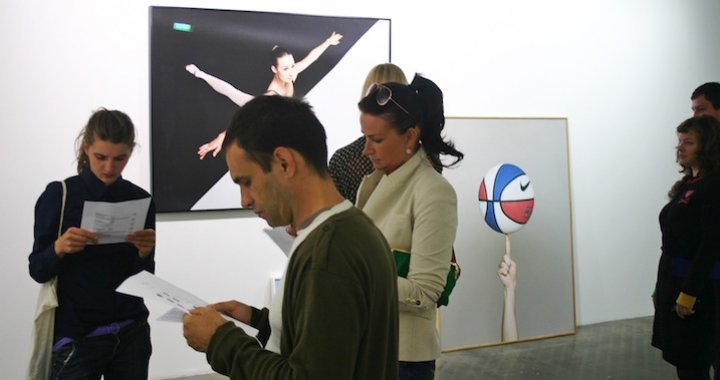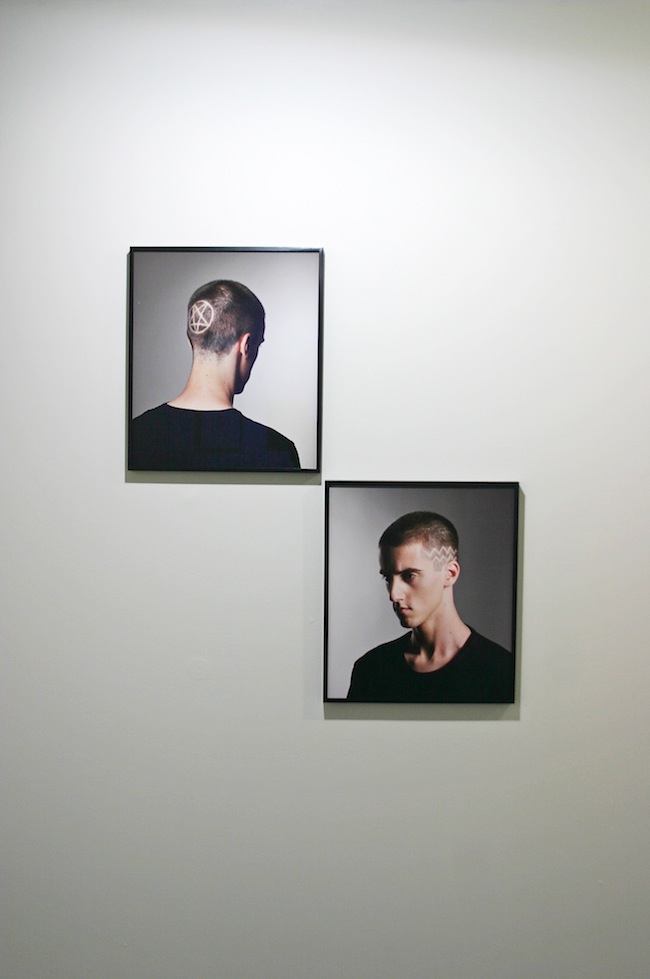
Personal “Solo exhibition”
06/09/2012
Kristīne Kursiša’s “Solo exhibition” served as a doctor’s office for me. Actually, ‘white cube’ type art spaces, in their sterility, quite often hold some associations with a hospital, that is, a special room and special conditions designed for recovery. However, the question always comes up – just who is ill? This time I think it is I. Visiting Kursiša’s exhibition, I feel that I have long been carrying around a growth, supplied with blood by my doubt of the critic’s task. On whether a work of art is a riddle with a single correct answer, known only to the artist. Like the childhood guessing cards with a question and drawing on one side, and the correct answer on the other. The artist is holding an image in front of us, but only he sees the answer. And one of the tasks of the art critic would be to pass this message on to the viewer (after guessing it himself, of course, and clapping with joy in the case of success), so they could see the art through different eyes and understand “what the artist had meant”. The riddle would be solved, satisfaction gained, the show – really “seen”. Full stop. “In art, for some reason, there is a view that everything should be pre-chewed and placed in the mouth ready-to-eat,” Kristīne said in a recent interview. If the task of a critic was really to find and reveal the answer to a riddle, we could do without critics and ask the artist themselves to tell all. Maybe the job of the critic is to place everything in context. So be it. Kristīne Kursiša has created her exhibition as an intimate vocabulary. “The stories of the photographs hold nothing of global significance or societal worth, but they have a special meaning to the author,” says the short synopsis. Truly on a micro level. This exhibition is like a fragile cocoon, with no desire to confirm or stir up any major social issues of the times. It does not wish to be placed in any context outside the sole micro context known only to the artist and those closest to her (the show is dedicated to her husband). What is a critic to do? One could shrewdly turn all this around and announce that this cocoon is itself a product of its time and society. Namely, it is the desire - born in a constant collectivism, bustle of socialization and unremitting exchange of mini-thoughts - to grow a thick, thick skin and work on an individual idea that does not have to become universal, in order to be immediately ‘shared’. The critic proclaims that this is the concept embodied by the “Solo exhibition” cocoon. “I have no wish to introduce a single clear concept,” I hear Kristīne say stubbornly, with the ears of my imagination. At the same time, the critic keeps to his own just as stubbornly, looking for some sturdier branches to continue climbing along. Searches for a context, concept, answer and possibly even trend. (In his office, the doctor wipes off my sweat and continues listening). Recently, we wished to interview Ilmārs Blumbergs for the portal. He declined a traditional interview, since artists shouldn’t have to talk. So, how then do we reach that guess? Let’s imagine that there is no annotation at the show and that the press release does not mention a word regarding its concept. What else to do? Stand in front of the art work for a long time, even longer, very long, and think of one’s own personal answer? If so, how will the history of art keep spinning on, jumping as it does from one conceptual rock to the next? (The doctor notes that I have high blood pressure and my growth of thoughts is pulsing.) I stand opposite one of Kristīne Kursiša’s works. Two photographs behind glass, showing a boy from two different angles. Two different symbols have been shaved into his hair. I look at the boy’s hair and I really want to know what the artist herself has meant, and what it means to her. I look for a title, at least (“Untitled”). Alas, I must work it out myself.

P.S. It is no accident that I was able to focus my reflections on the conceptual level of the exhibition, since its technical aspects and design have set the bar high. This opens up the horizon for reflection, with no need to trip up on basic details.
06/09/2012
“Solo exhibition” by Kristīne Kursiša is on view at kim? Contemporary art centre, Riga, through September 23
Kristīne Kursiša’s “Solo exhibition” served as a doctor’s office for me. Actually, ‘white cube’ type art spaces, in their sterility, quite often hold some associations with a hospital, that is, a special room and special conditions designed for recovery. However, the question always comes up – just who is ill? This time I think that’s me. Visiting Kursiša’s exhibition, I feel that I have long been carrying around a growth, supplied with blood by my doubt of the critic’s task. On whether a work of art is a riddle with a single correct answer, known only to the artist. Like the childhood guessing cards with a question and drawing on one side, and the correct answer on the other. The artist is holding an image in front of us, but only he sees the answer. And one of the tasks of the art critic would be to pass this message on to the viewer (after guessing it himself, of course, and clapping with joy in the case of success), so they could see the art through different eyes and understand “what the artist had meant”. The riddle would be solved, satisfaction gained, the show – really “seen”. Full stop. “In art, for some reason, there is a view that everything should be pre-chewed and placed in the mouth ready-to-eat,” Kristīne said in a recent interview.
If the task of a critic was really to find and reveal the answer to a riddle, we could do without critics and ask the artist themselves to tell all. Maybe the job of the critic is to place everything in context. So be it. Kristīne Kursiša has created her exhibition as an intimate vocabulary. “The stories of the photographs hold nothing of global significance or societal worth, but they have a special meaning to the author,” says the short synopsis. Truly on a micro level. This exhibition is like a fragile cocoon, with no desire to confirm or stir up any major social issues of the times. It does not wish to be placed in any context outside the sole micro context known only to the artist and those closest to her (the show is dedicated to her husband). What is a critic to do? One could shrewdly turn all this around and announce that this cocoon is itself a product of its time and society. Namely, it is the desire - born in a constant collectivism, bustle of socialization and unremitting exchange of mini-thoughts - to grow a thick, thick skin and work on an individual idea that does not have to become universal, in order to be immediately ‘shared’. The critic proclaims that this is the concept embodied by the “Solo exhibition” cocoon. “I have no wish to introduce a single clear concept,” I hear Kristīne say stubbornly, with the ears of my imagination. At the same time, the critic keeps to his own just as stubbornly, looking for some sturdier branches to continue climbing along. Searches for a context, concept, answer and possibly even trend. (In his office, the doctor wipes off my sweat and continues listening).
Recently, we wished to interview the Latvian artist Ilmārs Blumbergs for the portal. He declined a traditional interview, since artists shouldn’t have to talk. So, how then do we reach that guess? Let’s imagine that there is no annotation at the show and that the press release does not mention a word regarding its concept. What else to do? Stand in front of the art work for a long time, even longer, very long, and think of one’s own personal answer? If so, how will the history of art keep spinning on, jumping as it does from one conceptual rock to the next? (The doctor notes that I have high blood pressure and my growth of thoughts is pulsing.) I stand opposite one of Kristīne Kursiša’s works. Two photographs behind glass, showing a boy from two different angles. Two different symbols have been shaved into his hair. I look at the boy’s hair and I really want to know what the artist herself has meant, and what it means to her. I look for a title, at least (“Untitled”). Alas, I must work it out myself.

P.S. It is no accident that I was able to focus my reflections on the conceptual level of the exhibition, since its technical aspects and design have set the bar high. This opens up the horizon for reflection, with no need to trip up on basic details.